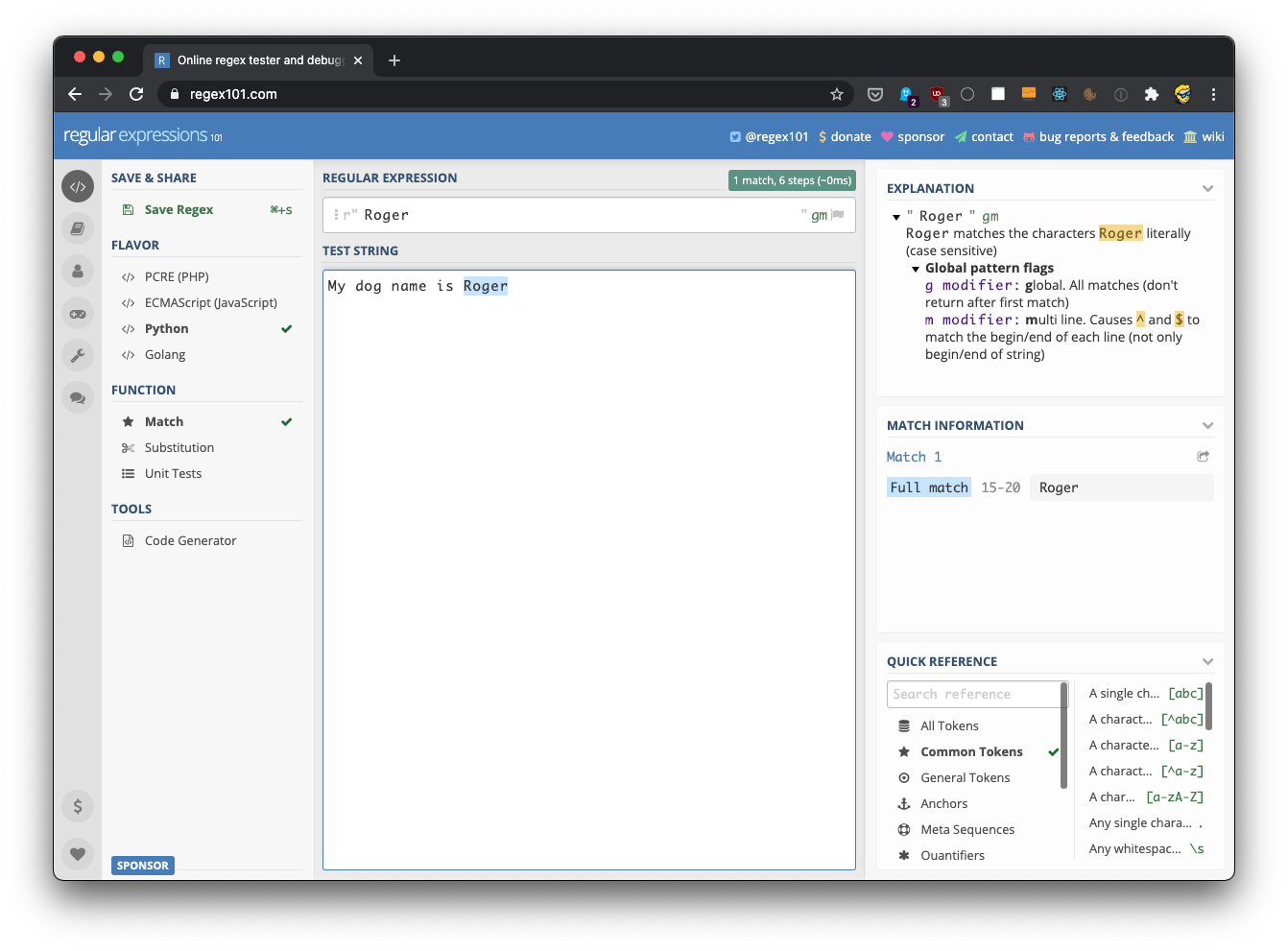Regular Expressions in Python
Regular expressions let us find content inside strings matching a particular format.
By formulating a regular expression with a special syntax, you can
- search text a string
- replace substrings in a string
- extract information from a string
The re Python standard library module gives us a set of tools to work with regular expressions.
In particular, among others it offers us the following functions:
re.match()checks for a match at the beginning of the stringre.search()checks for a match anywhere in the string
Both take take 3 parameters: the pattern, the string to search into, and the flags.
Before talking about how to use them, let’s introduce the basics of a regular expression pattern.
The pattern is a string wrapped in a r'' delimiter. Inside it, we can use some special combinations of characters we can use to capture the values we want.
For example:
.matches a single character (except the new line character)\wmatches any alphanumeric character ([a-zA-Z0-9_])\Wmatches any non-alphanumeric character\dmatches any digit\Dmatches anything that’s not a digit\smatches whitespace\Smatches anything that’s not whitespace
Square brackets can contain multiple characters matches: [\d\sa] matches digits and whitespaces, and the character a. [a-z] matches characters from a to z.
\ can be used to escape, for example to match the dot ., you should use \. in your pattern.
| means or
Then we have anchors:
^matches the beginning of a line$matches the end of a line
Then we have quantity modifiers:
?means “zero or one” occurrences*means “zero or more” occurrences+means “one or more” occurrences{n}means “exactlyn” occurrences{n,}means “at leastn” occurrences{n, m}means “at leastnand at mostm” occurrences
Parentheses, (<expression>), create a group. Groups are interesting because we can capture the content of a group.
Those 2 examples match the whole string:
re.match('^.*Roger', 'My dog name is Roger')
re.match('.*', 'My dog name is Roger')Printing one of those statements will result in a string like this:
<re.Match object; span=(0, 20), match='My dog name is Roger'>If you assign the result to a result variable and call group() on it, you will see the match:
result = re.match('^.*Roger', 'My dog name is Roger')
print(result.group())
# My dog name is RogerLet’s try to get the name of the dog, if you don’t know what is going to be the name of the dog, you can look for “name is ” and then add a group, like this:
result = re.search('name is (.*)', 'My dog name is Roger')result.group() will print “name is Roger”, and result.group(1) will print the content of the group, “Roger”:
print(result.group()) # name is Roger
print(result.group(1)) # RogerI mentioned re.search() and re.match() take flags as the 3rd parameter. We have a few possible flags, the most used is re.I to perform a case-insensitive match.
This is just an introduction to regular expressions, starting from this there’s a lot of rabbit holes you can go into.
I recommend trying your regular expressions on https://regex101.com for correctness. Make sure you choose the Python flavor in the sidebar.

download all my books for free
- javascript handbook
- typescript handbook
- css handbook
- node.js handbook
- astro handbook
- html handbook
- next.js pages router handbook
- alpine.js handbook
- htmx handbook
- react handbook
- sql handbook
- git cheat sheet
- laravel handbook
- express handbook
- swift handbook
- go handbook
- php handbook
- python handbook
- cli handbook
- c handbook
subscribe to my newsletter to get them
Terms: by subscribing to the newsletter you agree the following terms and conditions and privacy policy. The aim of the newsletter is to keep you up to date about new tutorials, new book releases or courses organized by Flavio. If you wish to unsubscribe from the newsletter, you can click the unsubscribe link that's present at the bottom of each email, anytime. I will not communicate/spread/publish or otherwise give away your address. Your email address is the only personal information collected, and it's only collected for the primary purpose of keeping you informed through the newsletter. It's stored in a secure server based in the EU. You can contact Flavio by emailing flavio@flaviocopes.com. These terms and conditions are governed by the laws in force in Italy and you unconditionally submit to the jurisdiction of the courts of Italy.